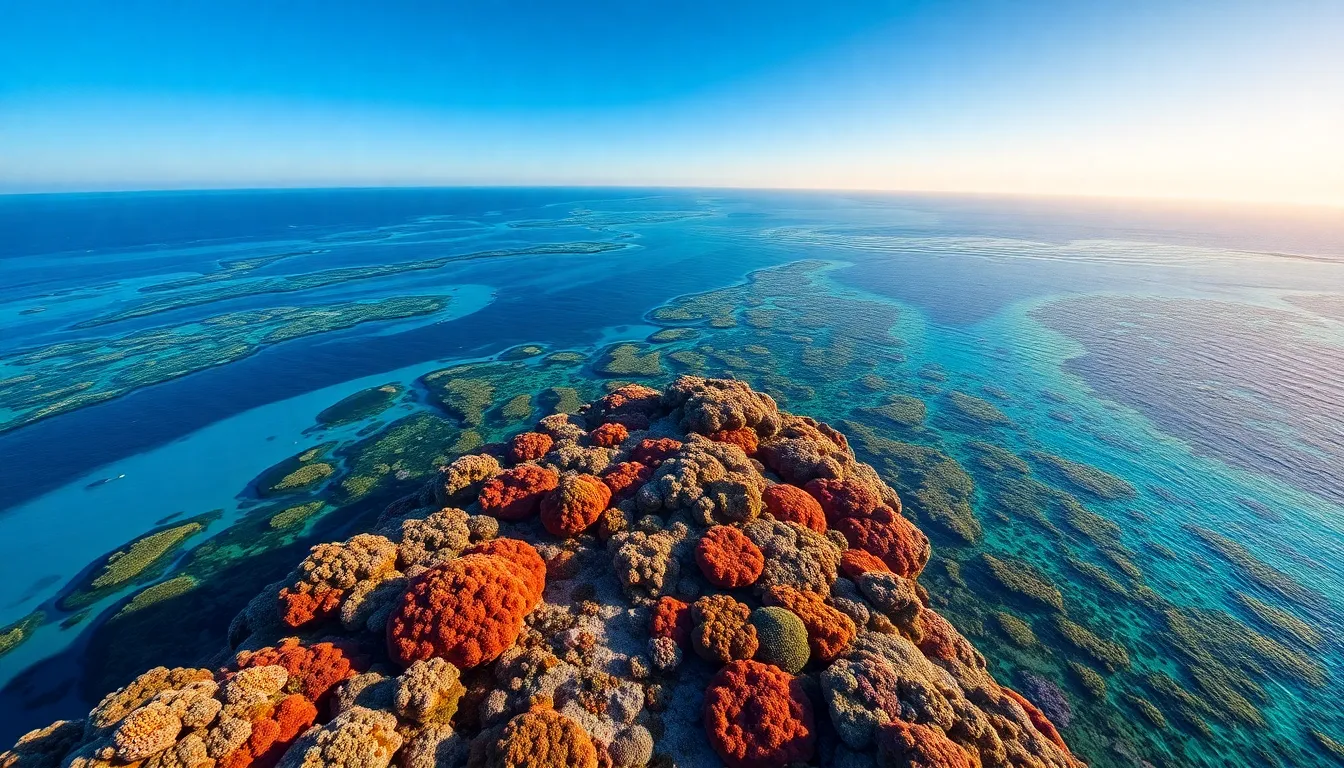World Heritage Sites represent the pinnacle of cultural and natural treasures that humanity has to offer. These extraordinary locations, recognized by UNESCO, showcase the incredible diversity of our planet’s history and achievements. From ancient ruins to breathtaking landscapes, each site tells a unique story that connects people across generations.
As travelers seek meaningful experiences, World Heritage Sites provide an unparalleled opportunity to explore the world’s most significant landmarks. They not only preserve the beauty and heritage of diverse cultures but also inspire a sense of responsibility to protect these irreplaceable treasures for future generations. Discovering these sites invites everyone to appreciate the rich tapestry of human civilization and the natural wonders that define our world.
Table of Contents
ToggleOverview of World Heritage Sites
World Heritage Sites encompass significant cultural and natural locations recognized by UNESCO. These locations reflect the diversity of human civilization and the richness of the natural environment. Each site possesses outstanding universal value, contributing to the global heritage narrative.
World Heritage Sites number over 1,100 as of 2023, distributed across more than 167 countries. They include a vast range of entities, from ancient ruins, such as the Great Wall of China, to breathtaking natural landscapes like Yellowstone National Park. Sites are categorized into cultural, natural, or mixed, depending on their primary importance.
Cultural sites cover historical monuments, cities, and landscapes, emphasizing achievements in architecture, art, and traditions. Notable examples include the Pyramids of Egypt and the Acropolis of Athens. Natural sites highlight ecological formations, unique biodiversity, and natural phenomena. Examples include the Great Barrier Reef and Mount Kilimanjaro.
The selection process for World Heritage Sites includes rigorous criteria and assessments by advisory bodies, ensuring that only the most deserving locations receive recognition. This designation raises awareness of the importance of conservation efforts, while boosting tourism and education in those areas. By sharing knowledge and experiences, communities can foster a global appreciation for the historical and ecological significance of these extraordinary sites.
Importance of World Heritage Sites

World Heritage Sites play a crucial role in preserving cultural and natural heritage. Their significance extends beyond mere recognition, impacting global culture and conservation.
Cultural Significance
Cultural World Heritage Sites illustrate the achievements of human civilization. They encompass a range of expressions, including architecture, art, and traditions. Sites like the Pyramids of Egypt and the Acropolis of Athens represent not only historical advances but also cultural identities that shape communities. They provide educational opportunities, enabling visitors to learn about different cultures and histories. Furthermore, cultural heritage fosters a sense of belonging, connecting people to their ancestry and shared narratives. The preservation of these sites helps maintain cultural diversity in an increasingly homogenized world.
Environmental Significance
Natural World Heritage Sites emphasize the importance of biodiversity and ecological conservation. They protect unique ecosystems and habitats that support countless species. The Great Barrier Reef and Yellowstone National Park illustrate the need for environmental stewardship. Designation as a World Heritage Site raises awareness about environmental challenges such as climate change and habitat loss. These locations serve as critical areas for scientific research, contributing to knowledge about ecological resilience. Supporting conservation efforts in these regions ensures the sustainability of natural resources for future generations.
Criteria for Selection
World Heritage Sites undergo a stringent selection process, guided by well-defined criteria established by UNESCO. These criteria ensure that sites represent outstanding universal value from various perspectives, including cultural, historical, and natural significance. The selection criteria include:
- Criterion (i): Represent a masterpiece of human creative genius.
- Criterion (ii): Exhibit a significant interchange of human values, over a span of time or within a cultural area, in developments in architecture or technology, monumental arts, or town-planning.
- Criterion (iii): Contain features that testify to a cultural tradition or to a civilization that is living or has disappeared.
- Criterion (iv): Be an outstanding example of a type of building, architectural or technological ensemble, or landscape that illustrates significant stages in human history.
- Criterion (v): Be an outstanding example of a traditional human settlement, land use, or sea use which is representative of a culture or human interaction with the environment.
- Criterion (vi): Be directly or tangibly associated with events or living traditions, with ideas, or with beliefs of outstanding universal significance.
- Criterion (vii): Contain superlative natural phenomena or areas of exceptional natural beauty and aesthetic importance.
- Criterion (viii): Be outstanding examples representing significant ongoing ecological and biological processes.
- Criterion (ix): Be outstanding examples of biological evolution and the development of ecosystems and communities of animals and plants.
- Criterion (x): Contain the most important and significant natural habitats for in-situ conservation of biological diversity.
The nomination process involves comprehensive documentation and evaluation, where experts assess each site’s eligibility based on these criteria. The final decision rests with the World Heritage Committee, which meets annually to evaluate nominations and select sites for inclusion on the World Heritage List. Only those that fulfill one or more of these criteria receive the prestigious designation, reflecting their exceptional global importance.
Notable World Heritage Sites
World Heritage Sites reflect humanity’s most treasured cultural and natural legacies. Among these, two primary categories stand out: historical landmarks and natural wonders.
Historical Landmarks
Historical landmarks represent significant achievements in architecture and human endeavor. Examples include:
- Pyramids of Egypt: These iconic structures reflect ancient Egyptian civilization’s architectural prowess and cultural depth.
- Acropolis of Athens: This site illustrates the artistry and philosophical advances of ancient Greece, symbolizing democracy and cultural heritage.
- Machu Picchu: Nestled in the Andes, this Incan citadel showcases remarkable engineering and connects history with breathtaking landscapes.
- Colosseum in Rome: This amphitheater highlights Roman engineering and serves as a testament to the grandeur of ancient entertainment and public life.
- Taj Mahal: This mausoleum exemplifies Mughal architecture’s beauty and remains a symbol of love and devotion.
Natural Wonders
Natural wonders showcase Earth’s extraordinary landscapes and biodiversity. Key examples include:
- Great Barrier Reef: The world’s largest coral reef system, it hosts an array of marine life and underscores the importance of marine conservation.
- Yellowstone National Park: This park features geothermal activity and diverse ecosystems, representing significant natural phenomena in the United States.
- Amazon Rainforest: As one of the most biodiverse areas on the planet, it plays a crucial role in global climate regulation and ecological balance.
- Grand Canyon: This landmark demonstrates the power of erosion and geology, offering insights into Earth’s history and geological processes.
- Stone Forest of Madagascar: This unique formation consists of sharp limestone pillars and is home to endemic species, showcasing evolutionary diversity.
These sites exemplify the shared heritage of humanity and the natural world, highlighting the need for their preservation and protection.
Challenges in Preservation
World Heritage Sites face numerous challenges that threaten their integrity and longevity. Understanding these threats and conservation efforts is crucial for safeguarding these significant cultural and natural treasures.
Threats to World Heritage Sites
Several threats jeopardize World Heritage Sites, including:
- Climate Change: Climate change intensifies weather patterns, leading to flooding, erosion, and habitat alteration. Coastal and low-lying sites are particularly vulnerable to rising sea levels.
- Urbanization: Rapid urban growth often encroaches on adjacent heritage sites, resulting in pollution, infrastructure development, and habitat loss. Urban expansion compromises site preservation and visitor experience.
- Tourism Pressure: High visitor numbers can cause physical damage to monuments, landscapes, and ecosystems. Overcrowding can lead to resource depletion and disrupt local communities.
- Conflict and War: Sites in politically unstable regions may experience vandalism, looting, and destruction during conflicts. Armed conflicts have historically led to irreparable damage to cultural heritage.
- Natural Disasters: Earthquakes, floods, and wildfires can devastate World Heritage Sites. Preparedness and response strategies often lag, leaving sites inadequately protected against such events.
Conservation Efforts
Various organizations and initiatives work to protect World Heritage Sites through:
- UNESCO’s Action Plans: UNESCO develops action plans that outline conservation strategies and funding requirements. These plans adapt to specific site challenges and prioritize resilience.
- Community Involvement: Engaging local communities fosters stewardship and sustainable practices. Education programs highlight the significance of preserving heritage for cultural and economic benefits.
- Sustainable Tourism Initiatives: Implementing regulations on visitor access and encouraging eco-friendly tourism practices mitigate negative impacts. This approach balances preservation with community economic needs.
- Scientific Research: Ongoing research into site conditions, biodiversity, and climate impacts informs preservation strategies. Local and international experts contribute valuable data for effective interventions.
- International Collaboration: Partnerships between governments, NGOs, and academic institutions enhance resources and expertise for site preservation. Collaborative efforts allow for sharing best practices across global contexts.
Future of World Heritage Sites
Future efforts to protect World Heritage Sites focus on sustainability, community engagement, and innovative conservation strategies. Policymakers and conservationists aim to integrate local perspectives into management plans, ensuring that communities are active stakeholders in preservation efforts.
Technological advancements increasingly play a role in monitoring and protecting these sites. Drones, remote sensing, and AI-powered analytics aid in assessing environmental changes, providing valuable data to identify threats. These technologies support immediate action to mitigate damage and reinforce conservation strategies.
Global collaboration also strengthens future preservation. International partnerships facilitate knowledge exchange and resource sharing between countries, enhancing strategies to combat common threats such as climate change and urbanization. Collaborative projects focus on capacity building, enabling nations to implement best practices in conservation.
Tourism management strategies will adapt to balance visitor access and site protection. Sustainable tourism practices emphasize minimizing environmental impact, fostering responsible travel behavior, and enhancing visitor education. Such initiatives aim to raise awareness of the significance of these sites and the need for their preservation.
Investment in education remains critical for the ongoing protection of World Heritage Sites. Community-based programs educate local populations about their cultural and natural heritage, fostering pride and stewardship. Educational initiatives encourage the next generation to engage with and protect these invaluable resources.
Overall, the future of World Heritage Sites hinges on the commitment of global communities to prioritize sustainable practices, innovative technologies, and shared responsibility for preservation.
World Heritage Sites stand as vital links to humanity’s cultural and natural legacy. Their preservation is essential not only for future generations but also for fostering a deeper understanding of our shared history and environment. As challenges like climate change and urbanization continue to threaten these treasures, the commitment to sustainable practices and community involvement becomes increasingly crucial.
Innovative technologies and global collaboration can enhance conservation efforts, ensuring that these sites remain protected and accessible. Ultimately, the responsibility to safeguard World Heritage Sites lies with everyone, as they embody the collective heritage of humanity and the planet.









